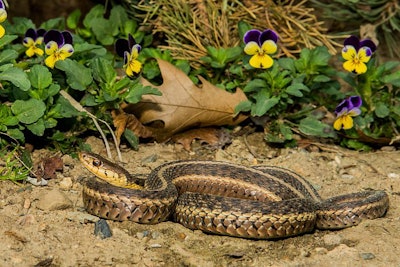
My childhood pet garter snake, ZigZag or Ziggy for short, seemed friendly enough for a reptile. She didn’t bite me. I considered her a friend, but I don’t know if the feeling was mutual. However, maybe she could have made friends with another of her own kind (Thamnophis sirtalis sirtalis), according to the results of a study published in Behavioral Ecology and Sociobiology.
Scientists observed eastern garter snakes actively seeking social interaction and preferring to remain with larger groups in an experiment at Wilfrid Laurier University in Ontario, Canada. The reptiles didn’t randomly mix with each other either. They chose to repeatedly associate with specific individual snakes or groups, even after the researchers shuffled their locations twice daily.
Although these snakes buddied up under laboratory conditions, wild garter snakes too may form social links, though the researchers could only speculate on that or its implications for conservation and wildlife management. Garter snakes’ ability and impulse to form social bonds may benefit the reptiles by helping to conserve warmth and watch out for predators, but is that friendship? The study’s authors discussed the difficulties of typifying reptile behavior as friendship in National Geographic.
Historically, anthropocentric biases stymied scientists’ ability to study the phenomenon of friendship among animals. As researchers break free from dogmas, they find empirical evidence for similarities among humans and other species. Words like friend can now be applied to Homo and Thamnophis. We often wrap it in sentimental, rather than scientific, language, but protecting and supporting each other is what human friends do too. Likewise, pets, our animal friends, provide the same biological boosts by helping, comforting and guarding us.
Humanization trend in reptile pet ownership
Reptiles lack an essential characteristic to be fur babies. Nevertheless, pet owners do consider their cold-blooded pets with warmth. In a survey by Packaged Facts, 85% of “other pet” owners, a catch-all category that included reptile owners, considered their pets to family members, according to promotional materials for the report “Reptile Products: U.S. Pet Market Trends and Opportunities.”
“The ‘reptiles as family’ trend further suggests new opportunities for premiumization along the lines of supplies ever more reminiscent of what a reptile would experience in the wild,” Packaged Facts analysts wrote.
Packaged Facts analysts noted that reptile pets’ take up less space in a home and therefore meet younger and urban pet owners demands for smaller pets. Food and other expenses for pets tend to be lower than those of dogs, cats and other warm-blooded pets. Economic considerations now have urgency as unprecedented unemployment weakens already ailing communities.
“Pandemic notwithstanding, the reptile business may therefore be poised for growth, both because of the heightened levels of comfort and affection pet owners are finding in their pets due to social distancing and being home bound, and because children—who during the stay-at-home period need more than ever to be entertained—are a key factor to the household ownership of reptiles,” wrote Packaged Facts analysts.
Humanization of reptile pets stands as another step towards understanding the similarities among all living things. Reptile pets teach people what scientists observe as well: animals differ from humans in degree not type. While we humanize our cold-blooded pets, perhaps we could benefit from reptile-izing ourselves. As the pandemic continues, our pet turtles may have a few lessons for us.














